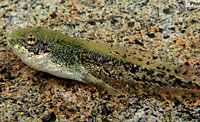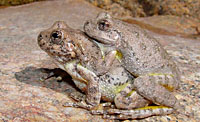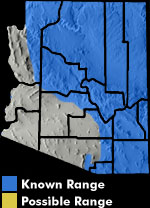Online Field Guide to The Reptiles and Amphibians of Arizona


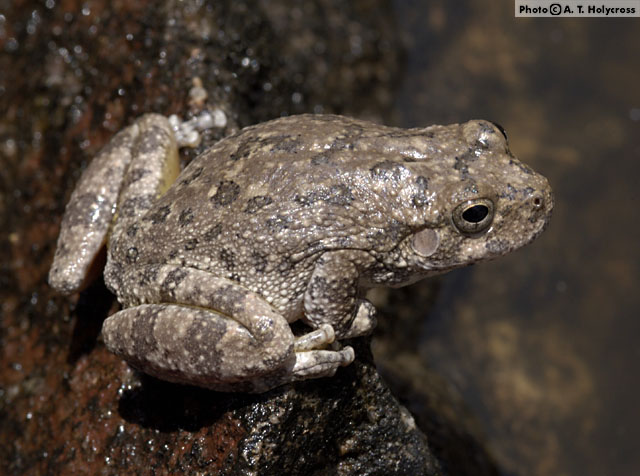
Santa Cruz County, AZ
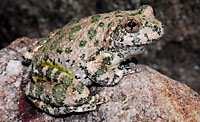 Gila Co., AZ |
| CANYON TREEFROG Hyla arenicolor | |
|
DESCRIPTION: The canyon treefrog is a relatively small (to about 2.2 inches), rough-skinned frog with large adhesive toe pads for climbing. It is a gray, tan, or olive frog typically with green or gray blotches or spots, but sometimes lacking spots. It lacks a dark stripe through the eye, and the toes on the hind feet are webbed. Adult males have a dark throat patch and frogs often have considerable yellow or orange in the groin and inner thighs. Tadpoles typically have dark spots and patches, and become speckled with golden or bronze coloration as they mature. They grow to about 1.5 inches prior to metamorphosis. DISTRIBUTION: This species is widely-distributed in Arizona outside of the Sonoran and Mohave Deserts. This frog ventures into the edge of the deserts, but the desert’s boundaries come close to defining the species’ western-most distribution. HABITAT: As its name implies, it is a frog of canyons and arroyos, particularly rocky, intermittent or permanent stream courses. Canyon treefrogs are found from the desert’s edge to high in the mountains where it occurs in chaparral, pinyon-juniper, oak, pine-oak, and mixed conifer woodlands. They are sometimes been found in montane talus slopes, apparently far from water. BEHAVIOR: On warm evenings they can be found at or near the water’s edge, but during the day or dry periods they take refuge in rock crevices or on rock faces, or less commonly on or in trees near the canyon bottom. In the spring or summer it is not uncommon to find several of these frogs crowded together, lining a shallow rock crevice. In such crevices or on granite boulders, they are particularly well camouflaged. At dusk they climb down from their day perch and move towards water to forage or breed. They often return to the same day perch for several or many days in succession. DIET: Canyon treefrogs feed upon a number of small invertebrates, such as beetles, caddisflies, and true bugs. REPRODUCTION AND CALLS: Breeding occurs both in the spring and during the early part of the summer monsoon. The call, given by the male, is a loud, rattling series of short trills that sound like they are coming from inside a tin can. The call is surprisingly loud given the small size of this frog. Calls are heard mostly after dark, but some individuals will call during day, particularly during or after a rainstorm. One hundred or more eggs are laid in a mass that may be free-floating or attached to vegetation. The eggs hatch in less than two weeks and tadpoles typically metamorphose in 45-75 days. Eggs deposited late in the breeding season may overwinter. REMARKS: Skin secretions of this frog can irritate eyes and nose. Canyon treefrogs in Arizona have tested positive for the fungal disease chytridiomycosis, but there is no evidence that they are adversely affected. Brennan, T.C., and A.T. Holycross. 2006. A Field Guide to Amphibians and Reptiles in Arizona. Arizona Game and Fish Department. Phoenix, AZ. Degenhardt, W.G., C.W. Painter, and A.H. Price. 1996. Amphibians and Reptiles of New Mexico. University of New Mexico Press, Albuquerque, NM. Ivanyi, C., and J. Perry. 2000. Canyon treefrog (Hyla arenicolor). Page 540 in S.J. Phillips and P.W. Comus (eds), A Natural History of the Sonoran Desert. Arizona-Sonora Desert Museum Press, Tucson, and the University of California Press, Berkeley, CA. Painter, C.W. 2005. Hyla arenicolor Cope, 1866(a), Canyon treefrog. Pages 447-448 in M.J. Lannoo (ed), Amphibian Declines: The Conservation Status of United States Species. University of California Press, Berkeley, CA. Zweifel, R.G. 1961. Larval development of the treefrogs Hyla arenicolor and Hyla wrightorum. American Museum Noviates 2056:1-19 |
|
Visit Partners in Amphibian and Reptile Conservation:


HOME
Copyright © 2023, Arizona Game and Fish Department. All rights reserved.
If you make use of the textual contents of this site in reports, publications, etc. please cite and credit the author(s) and photographer(s). All photos on this website are copyrighted. However, those found in the species account section may be used for any noncommercial scientific, educational, or conservation purposes provided that photographs are not altered and continue to bear the copyright symbol and name of the photographer. Please contact the photographer regarding commercial use of copyrighted photographs.










